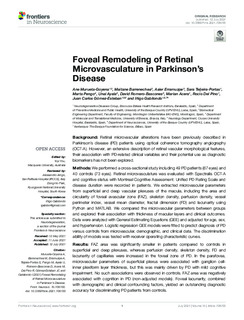| dc.rights.license | Attribution 4.0 International | * |
| dc.contributor.author | Barrenechea, Maitane | |
| dc.contributor.author | Erramuzpe Aliaga, Asier | |
| dc.contributor.author | Ayala, Unai | |
| dc.contributor.author | Romero-Bascones, David | |
| dc.contributor.other | Murueta Goyena, Ane | |
| dc.contributor.other | Teijeira, Sara | |
| dc.contributor.other | Pengo, Marta | |
| dc.contributor.other | Acera, Marian | |
| dc.contributor.other | Pino, Rocío Del | |
| dc.contributor.other | Gómez Esteban, Juan Carlos | |
| dc.contributor.other | Gabilondo Cuellar, Iñigo | |
| dc.date.accessioned | 2023-03-28T18:21:41Z | |
| dc.date.available | 2023-03-28T18:21:41Z | |
| dc.date.issued | 2021 | |
| dc.identifier.issn | 1662-453X | en |
| dc.identifier.other | https://katalogoa.mondragon.edu/janium-bin/janium_login_opac.pl?find&ficha_no=163784 | en |
| dc.identifier.uri | https://hdl.handle.net/20.500.11984/6067 | |
| dc.description.abstract | Background: Retinal microvascular alterations have been previously described in Parkinson’s disease (PD) patients using optical coherence tomography angiography (OCT-A). However, an extensive description of retinal vascular morphological features, their association with PD-related clinical variables and their potential use as diagnostic biomarkers has not been explored.
Methods: We performed a cross-sectional study including 49 PD patients (87 eyes) and 40 controls (73 eyes). Retinal microvasculature was evaluated with Spectralis OCT-A and cognitive status with Montreal Cognitive Assessment. Unified PD Rating Scale and disease duration were recorded in patients. We extracted microvascular parameters from superficial and deep vascular plexuses of the macula, including the area and circularity of foveal avascular zone (FAZ), skeleton density, perfusion density, vessel perimeter index, vessel mean diameter, fractal dimension (FD) and lacunarity using Python and MATLAB. We compared the microvascular parameters between groups and explored their association with thickness of macular layers and clinical outcomes. Data were analyzed with General Estimating Equations (GEE) and adjusted for age, sex, and hypertension. Logistic regression GEE models were fitted to predict diagnosis of PD versus controls from microvascular, demographic, and clinical data. The discrimination ability of models was tested with receiver operating characteristic curves.
Results: FAZ area was significantly smaller in patients compared to controls in superficial and deep plexuses, whereas perfusion density, skeleton density, FD and lacunarity of capillaries were increased in the foveal zone of PD. In the parafovea, microvascular parameters of superficial plexus were associated with ganglion cell-inner plexiform layer thickness, but this was mainly driven by PD with mild cognitive impairment. No such associations were observed in controls. FAZ area was negatively associated with cognition in PD (non-adjusted models). Foveal lacunarity, combined with demographic and clinical confounding factors, yielded an outstanding diagnostic accuracy for discriminating PD patients from controls.
Conclusion: Parkinson’s disease patients displayed foveal microvascular alterations causing an enlargement of the vascular bed surrounding FAZ. Parafoveal microvascular alterations were less pronounced but were related to inner retinal layer thinning. Retinal microvascular abnormalities helped discriminating PD from controls. All this supports OCT-A as a potential non-invasive biomarker to reveal vascular pathophysiology and improve diagnostic accuracy in PD. | en |
| dc.description.sponsorship | Gobierno Vasco-Eusko Jaurlaritza | es |
| dc.description.sponsorship | Gobierno de España | es |
| dc.language.iso | eng | en |
| dc.publisher | Frontiers | en |
| dc.rights | © 2021 The Authors | en |
| dc.rights.uri | http://creativecommons.org/licenses/by/4.0/ | * |
| dc.subject | neurodegeneration | en |
| dc.subject | angiography | en |
| dc.subject | capillary | en |
| dc.subject | density | en |
| dc.subject | Parkinson’s disease | en |
| dc.subject | retina | en |
| dc.subject | optical coherence tomography | en |
| dc.subject | biomarker | en |
| dc.title | Foveal Remodeling of Retinal Microvasculature in Parkinson’s Disease | en |
| dc.type | http://purl.org/coar/resource_type/c_6501 | |
| dcterms.accessRights | http://purl.org/coar/access_right/c_abf2 | en |
| dcterms.source | Frontiers in Neurosciences | en |
| local.contributor.group | Teoría de la señal y comunicaciones | es |
| local.description.peerreviewed | true | en |
| local.identifier.doi | https://doi.org/10.3389/fnins.2021.708700 | en |
| local.relation.projectID | info:eu-repo/grantAgreement/GV/Ayudas a proyectos de investigación y desarrollo en salud 2020/2020333033/CAPV/Aplicación clínica de la inteligencia artificial sobre imágenes de OCT de retina para la clasificación precoz y monitorización de pacientes con enfermedad de Parkinson/OCT | en |
| local.relation.projectID | info:eu-repo/grantAgreement/GE/Instituto de Salud Carlos III/PI14-00679/ES/Estudio por neuroimagen de los portadores de la mutación E46K del gen de la alfa sinucleína como modelo de enfermedad por cuerpos de Lewy idiopática/ | en |
| local.relation.projectID | info:eu-repo/grantAgreement/GE/Instituto de Salud Carlos III/PI16-00005/ES/Identificación de biomarcadores de la retina y la vía visual en formas genéticas de enfermedad de Parkinson como un modelo para enfermedad de Parkinson idiopática/ | en |
| local.contributor.otherinstitution | https://ror.org/000xsnr85 | eu |
| local.contributor.otherinstitution | https://ror.org/02q2d2610 | en |
| local.contributor.otherinstitution | https://ror.org/0061s4v88 | en |
| local.contributor.otherinstitution | https://ror.org/03nzegx43 | es |
| local.contributor.otherinstitution | https://ror.org/01cc3fy72 | en |
| oaire.format.mimetype | application/pdf | en |
| oaire.file | $DSPACE\assetstore | en |
| oaire.resourceType | http://purl.org/coar/resource_type/c_6501 | en |
| oaire.version | http://purl.org/coar/version/c_970fb48d4fbd8a85 | en |








